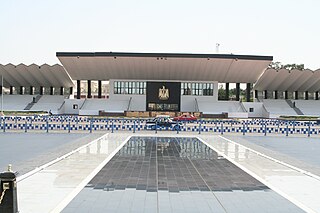
Terrorism in Egypt in the 20th and 21st centuries has targeted the Egyptian government officials, Egyptian police and Egyptian army members, tourists, Sufi Mosques and the Christian minority. Many attacks have been linked to Islamic extremism, and terrorism increased in the 1990s when the Islamist movement al-Gama'a al-Islamiyya targeted high-level political leaders and killed hundreds – including civilians – in its pursuit of implementing traditional Sharia law in Egypt.

Operation Eagle was an Egyptian military campaign in the Sinai Peninsula, that was launched in August 2011 to confront the Sinai insurgency. The campaign was aimed against Islamist insurgents, who had been attacking the Egyptian security forces in the Sinai and using the area as a base from which to attack Israel since early 2011. Successive Egyptian operation against insurgents in 2012, named Operation Sinai, was initially referred as the second part of Operation Eagle. It was the first in a number of campaigns to retake the Sinai from insurgents which was achieved.
Sheikh Zuweid is a Bedouin town in the North Sinai Governorate of Egypt near the border with the Gaza Strip. It is situated between the cities of Arish and Rafah and is 334 kilometers northeast of Cairo. It had a population of around 60,000 as of 2015.
The August 2012 Sinai attack occurred on 5 August 2012, when armed men ambushed an Egyptian military base in the Sinai Peninsula, killing 16 soldiers and stealing two armored cars, which they used to infiltrate into Israel. The attackers broke through the Kerem Shalom border crossing to Israel, where one of the vehicles exploded. They then engaged in a firefight with soldiers of the Israel Defense Forces (IDF), during which six of the attackers were killed. No Israelis were injured.

The Sinai insurgency was an insurgency campaign in the Sinai Peninsula of Egypt launched by Islamist militants against Egyptian security forces, which also included attacks on civilians. The insurgency began during the Egyptian Crisis, during which the longtime Egyptian president Hosni Mubarak was overthrown in the 2011 Egyptian revolution.

Operation Sinai was an Egyptian military campaign, launched in early August 2012, against Islamic militants within the Sinai Peninsula to crush the Sinai Insurgency. The operation came as a direct response to the 2012 Egyptian-Israeli border attack on 5 August 2012. The operation was initially reported as part of "Operation Nisr", but on 3 September 2012, the Egyptian army issued a statement requesting media sources to use the official name "Operation Sinai."

Ansar Bait al-Maqdis, or Ansar Al-Quds, was an Islamist jihadist, extremist terrorist group based in the Sinai Peninsula from 2011 to 2014.
Soldiers of Egypt was a Salafist Islamist militant group that operated near Cairo, Egypt. The group was founded by Humam Muhammed in 2013, after he split away from the Ansar Bait al-Maqdis militant group. The group claimed that its attacks were "retribution" for the August 2013 Rabaa Massacre; notably, the group targeted only security forces. It warned civilians of the presence of bombs that it placed.
On 24 October 2014, militant group Ansar Beit al-Maqdis ISIL launched two attacks on Egyptian Armed Forces positions in the Sinai Peninsula, killing at least 33 security personnel in one of the deadliest assaults on the Egyptian military in decades.
The following lists events that happened during 2015 in Egypt.
On 29 January 2015, militants from the ISIL-affiliated Wilayat Sinai militant group launched a series of attacks on army and police bases in Arish using car bombs and mortars. The attacks, which occurred in more than six different locations, resulted in 44 deaths.
The following is a chronological timeline of fatal incidents during the ongoing Sinai insurgency, which was invigorated by a period of relative instability and political turmoil in Egypt, beginning with the 2011 uprising against former autocrat Hosni Mubarak. Insurgent attacks, however, intensified significantly following the July 2013 coup that ousted Muslim Brotherhood-backed president Mohamed Morsi and subsequent crackdown on his supporters.

The Sheikh Omar Hadid Brigade, also known as Islamic State in Gaza, was an Islamist militant group affiliated with the Islamic State in Iraq and the Levant that was reportedly active in the Gaza Strip around 2015. Its goals have consistently matched those of the Islamic State, in that it seeks to establish the al-Sham caliphate. As such, it opposes all forms of Palestinian nationalism while also supporting the elimination of all Jews and other ethno-religious 'infidels' from the region.

Operation Martyr's Right was a military operation conducted by the Egyptian Armed Forces in cooperation with the Egyptian National Police officers, aimed at rooting out and killing jihadist militants.

The Islamic State – Sinai Province was a branch of the jihadist organization Islamic State that was active in the Sinai Peninsula of Egypt.
This article contains a timeline of events from January 2015 to December 2015 related to the Islamic State of Iraq and the Levant (ISIL/ISIS). This article contains information about events committed by or on behalf of the Islamic State, as well as events performed by groups who oppose them.

In July 2013, at the same time as mass protests began against the 3 July coup d'état which deposed Mohamed Morsi, and in parallel with the escalation of the already ongoing jihadist insurgency in the Sinai Peninsula, pro-Muslim Brotherhood militants started violent attacks against policemen and soldiers in central and western Egypt. In the following months, new Islamist armed groups were created to reinstate Islamist rule in Egypt, like Soldiers of Egypt and the Popular Resistance Movement. Since 2013, violence in mainland Egypt has escalated and developed into a low-level Islamist insurgency against the Egyptian government.
The 2016 el Arish attack was a mortar attack by ISIS on March 20, 2016 in which thirteen Egyptian policemen and soldiers were killed at a security checkpoint in Sinai's Al-Arish.

Colonel Ahmed Mansy was the commander of Egypt's Sa'ka Forces Thunderbolt Battalion 103.
This is a timeline of ISIL-related events that occurred in the year 2020.







